
Finding balance through yoga
Balance is key to a stable life and yoga can be a key means to finding it across all age groups.
By Fenella Lindsell
More than standing on one leg
Good balance is key to a functioning body. It helps prevent injuries, links to efficient muscular control, improves posture, reduces our chances of arthritis, back pain and other health issues.
On a social level, poor balance affects people differently. In the elderly, it can limit the activities they feel confident doing. This can lead to increased isolation and a reduction in physical health if they are forced to withdraw form a more active lifestyle.
For younger and middle aged people, balance is important for exercise and also some types of work. Poor balance means people can miss out on healthy parts of life, such as sports engagement and other activities which increase our physical wellbeing, as well as involvement in communities and regulating important parts of our brain's health.

The science
We have very upright bodies with a heavy head at the top of it – so there is a good deal of effort required to stabilise our wobbly wanderings.
Balance is made up of a sensory system and, as with any sensory system, stimuli is gathered from outside the brain and then processed internally, sending information to the body and carrying out important functions. For sight, this information is light from outside that we process and make into conceivable images. For balance, the information is motion based and relies on a complex structure in our inner ear.
We have five balance receptors in the inner ear that deal with different types of movement. Three are for head movement, one is for upward acceleration and the final one is for lateral acceleration, like sideways movement.
These balance receptors are tubes filled with fluid. Inside the tubes are a series of hair cells (endolymph) that respond to movement in the fluid. As we move, the inner ear fluid moves and the hair cells inside get stimulated by the movement. Together, they form a picture of our balance, working in symphony, stimulating and relaxing as the liquid is moved. These balance receptors also influence the response of our eye muscles to enable stable vision and keep us upright.
The body and balance
There are some parts of the body that are more important than others when it comes to balance. Unlike other forms of exercise, yoga targets an inclusive range of muscle groups all over the body and, as a result, has significant impact on regions that can improve our balance. Three regions are particularly important.
Core: Made of 28 muscles, this region helps to stabilise our hips, shoulders and spine.
Legs and glutes: When these are strong, they enable us to walk on uneven terrain, steep gradients and allow us to stand and sit easily among other things.
Feet and toes: Our big toe, little toe and heel create a tripod with the ability to shift weight across these three points in response to where the rest of the body is positioned. A study by Choue et al. focused on the big toe in balance and found that when the big toe was constrained or unable to properly function, subjects were significantly worse at balancing. It is estimated that as much as 80-90% of foot control comes from the big toe.

Yoga and balance
Yoga is essential for improving muscular strength and flexibility across the entire body. With most poses in yoga the core is activated and tested. Over time, this means the core is strengthened. Muscles that help keep our posture aligned are important for maintaining good balance and good body position during movement.
Elderly people
Some studies have shown that yoga provides benefits to balance and in particular, improves physical mobility in people aged 60 years and older. Another study in 2019 by Green et al. found that the benefits of yoga include improved posture control, improved flexibility of mind and body, relaxation, and decreased anxiety and stress.
Also in 2019, a study by Patel et al. concluded that yoga asanas (the physical postures we assume during hatha yoga practice) are effective in improving balance in elderly individuals in both the short and medium term.

Neurodiverse groups
Balance is also closely related with ADHD. This has been linked to issues with the cerebellum in the brain. The cerebellum is a region that controls motor activities and is often affected in those with ADHD, impacting motor functioning and therefore, balancing issues.
This means children with ADHD are more likely to experience postural sway which is a term used to describe the unconscious, small movements that happen around the body's centre of gravity in order to maintain balance. Up to 50% of children with ADHD experience poor balance from postural sway. One of the benefits of yoga is its ability to improve concentration (Sheela Joyce, 2018) which helps with our conscious balance. Also, yoga strengthens muscles that are important in the balancing process, such as core, glutes, legs and back.
What does our healthcare deal with in balance costs
The big picture
Balance is key to a stable life. When people have poor balance, our sense of movement and physicality is deeply affected and this can play out in ways that make people feel isolated in both young and elderly groups. It is clear that yoga can play a key role in improving balance by increasing focus, concentration and strengthening the muscle groups that help us to stay steady. Yoga is key to balance, and as they say – balance is the key to a healthy life.
Fenella Lindsell is a long-established yoga instructor and the founder of Yoga Forever (yoga-forever.com)




